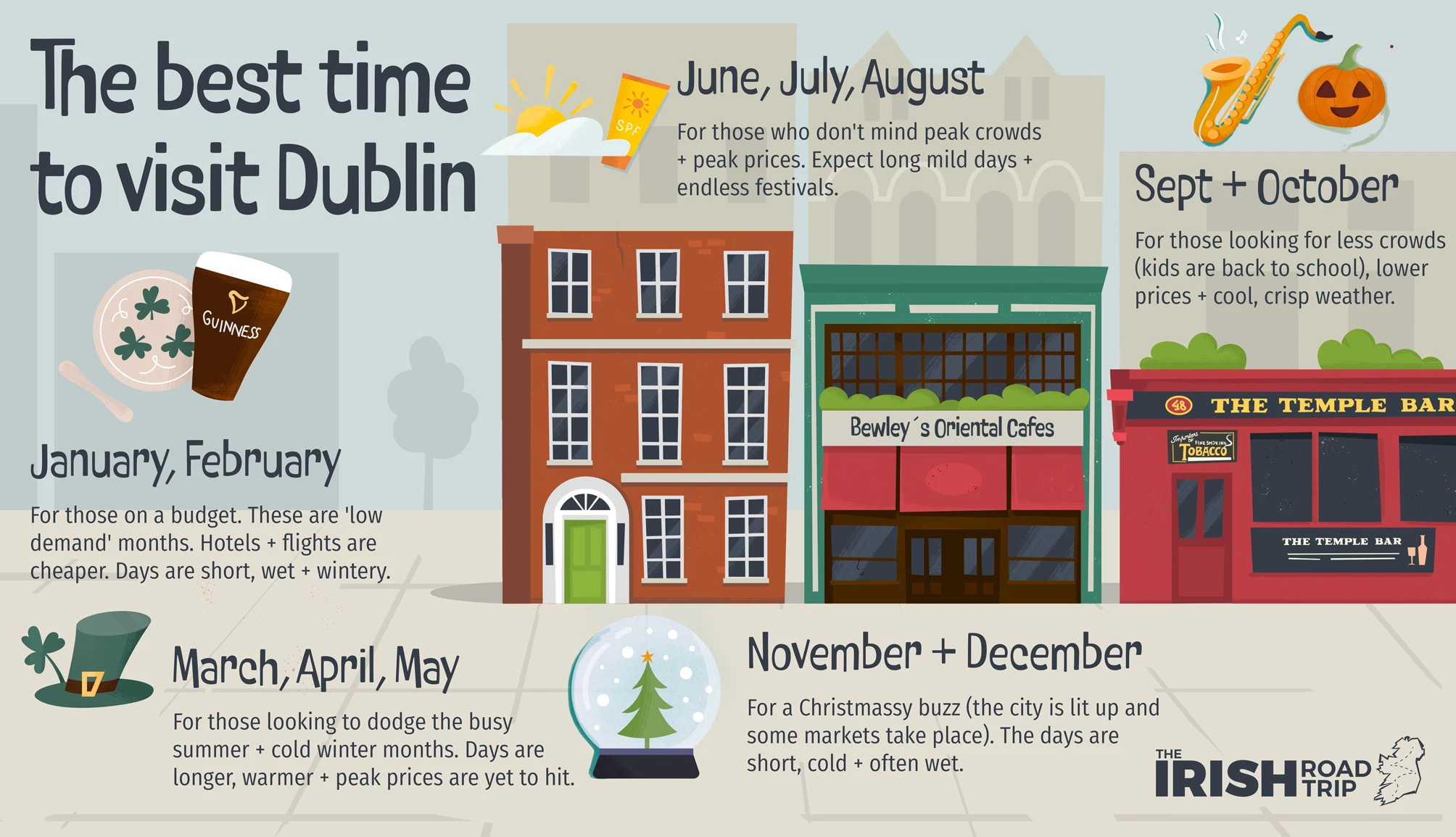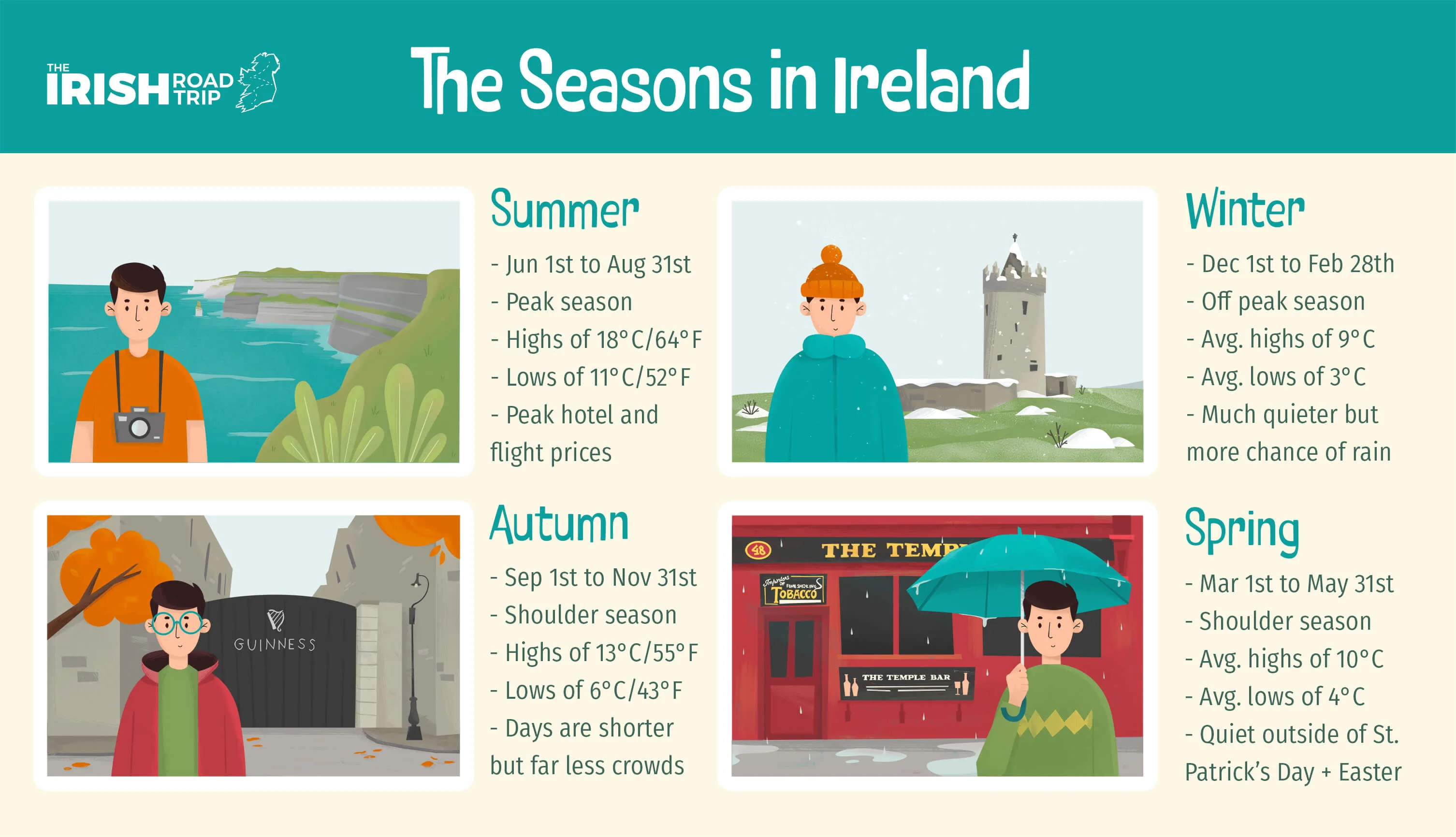There is no one best time to visit Dublin (and I’m saying that having lived here for 34 years).
There are, however, advantages and disadvantages to certain times of the year.
Planning a trip to Ireland is a tough aul task and, arguably, the single most important task that you need to make before looking at your Ireland itinerary is when you’ll visit.
Below, you’ll find a very clear process to follow that’ll help you decide when is the best time to go to Dublin based on YOUR likes and dislikes.
Some quick need-to-knows about the best time to visit Dublin
Picking the best time of year to go to Dublin requires you to weigh up the pros and cons associated with each month. Here’s some quick travel tips for Ireland to get you started:
1. When’s ‘Best’ depends on you
Take every single guide to the best month to visit Dublin with a massive pinch of salt! The best time of year to visit Dublin is going to be specific to YOU. It’s important that you consider the pros and cons of each month – never take someone else’s word on what’s ‘best’.
2. The pros and cons to consider
Each of the 4 seasons comes with their pros and cons. The summer months (June, July and August) boast long days with lots of daylight hours. The ‘Shoulder Season’ is less crowded, but winter has yet to sink its teeth in. More on this below.
3. It often comes down to a calculated bet
When deciding when to visit Dublin, you often feel like picking a month is a gamble, and it is. In an ideal world, summer in Dublin would be all sunshine and dry, warm days, but that’s often not the case, as you’ll discover below.
4. The seasons in Dublin
The seasons in Dublin are fairly straightforward; Summer in Dublin: June, July and August, Autumn in Dublin: September, October and November, Winter in Dublin: December, January and February and Spring in Dublin: March, April and May. Here are the tourist seasons:
- Peak season: June to September
- Shoulder season: April to May
- Off-peak: November to February
5. My opinion
Since publishing the world’s largest collection of Irish road trip itineraries, we get asked when is the best time of year to visit Dublin constantly. I’ve lived here for 34 years. In my opinion, it’s hard to beat May, September and October. You’ll see why below.
The best time to go to Dublin: A speedy overview of the climate by month
The second section of this guide will give you an insight into the best time to visit Dublin from a weather perspective.
Each table below contains the average temperatures for each month with data taken from the Irish Meteorological Service.
I’ve popped in several different years so you can get a sense of the weather in Dublin over a period of time.
The final column of each table contains the Long Term Average temperature for the month in question.
Summer (June, July and August)
| Month | 2022 | 2021 | 2020 | LTA |
|---|---|---|---|---|
| June | 13.6°C/56.48°F | 13.7°C/56.66°F | 13.4°C/56.12°F | 13.4°C/56.12°F |
| July | 16.3°C/61.34°F | 16.1°C/60.98°F | 14.4°C/57.92°F | 15.4°C/59.72°F |
| August | 15.9°C/60.62°F | 14.7°C/58.46°F | 14.7°C/58.46°F | 15.1°C/59.18°F |
Autumn (September, October and November)
| Month | 2022 | 2021 | 2020 | LTA |
|---|---|---|---|---|
| September | 13°C/55.4°F | 14.7°C/58.46°F | 12.8°C/55.04°F | 13.1°C/55.58°F |
| October | 12°C/53.6°F | 11.9°C/53.42°F | 9.5°C/49.1°F | 10.3°C/50.54°F |
| November | 8.8°C/47.84°F | 7.6°C/45.68°F | 8.2°C/46.76°F | 7.3°C/45.14°F |
Winter (December, January and February)
| Month | 2022 | 2021 | 2020 | LTA |
|---|---|---|---|---|
| December | 4.4°C/39.92°F | 6.5°C/43.7°F | 4.9°C/40.82°F | 5.6°C/42.08°F |
| January | 5.4°C/41.72°F | 3.9°C/39.02°F | 6.3°C/43.34°F | 5.3°C/41.54°F |
| February | 6.7°C/44.06°F | 6.2°C/43.16°F | 5.8°C/42.44°F | 5.3°C/41.54°F |
Spring (March, April and May)
| Month | 2022 | 2021 | 2020 | LTA |
|---|---|---|---|---|
| March | 6.6°C/43.88°F | 7.2°C/44.96°F | 5.8°C/42.44°F | 6.7°C/44.06°F |
| April | 7.6°C/45.68°F | 5.6°C/42.08°F | 8.5°C/47.3°F | 8.1°C/46.58°F |
| May | 11.9°C/53.42°F | 9.2°C/48.56°F | 10.9°C/51.62°F | 10.7°C/51.26°F |
Deciding on the best time of year to visit Dublin: A breakdown of each month with their pros and cons
Deciding when to visit Dublin can be stressful. One of the best ways to help you decide is to weigh up the pros and cons.
I’ve listed out the main advantages and disadvantages for each month below, based on the 34 years that I’ve spent living here.
January
Dublin in January tends to be cold, wet and wintery (as does the rest of Ireland).
The LTA (Long Term Average) temperature in Dublin in January is 5.3°C/41.54°F with average rainfall of 62.6mm.
Advantages
- Prices: If you’re visiting Ireland on a budget, flights and hotels in Dublin should be cheaper
- Crowds: Some of the more popular attractions in Dublin will be much quieter
Disadvantages
- The weather: The days tend to be cold, wet, and windy
- The days are short: At the beginning of the month the sun rises from 08:29 and sets from 16:38
February
Visiting Dublin in February can be another tricky one, especially if the weather will be your deciding factor.
The LTA (Long Term Average) temperature in Dublin in February is 5.3°C/41.54°F with rainfall of 48.8mm.
Spring is still far from the horizon and the days are short and chilly. In the past, we’ve had heavy snow fall, flooding and stormy weather in February.
Advantages
- Prices: February is off-season in Dublin, so flights and accommodation should be cheaper
- Crowds: Dublin’s usually hectic attractions will be much quieter (the likes of the Guinness Storehouse will always draw crowds, though)
Disadvantages
- Weather: The weather in February is very unpredictable
- Short days: At the start of the month the sun rises at 07:40 and sets at 17:37
March
March is regarded as the best time to go to Dublin by many that have been bitten by the St. Patrick’s Day buzz.
The LTA (Long Term Average) temperature in Dublin in March is 6.7°C/44.06°F with rainfall of 52.6mm.
Yes, there’s a great buzz around the country for the 17th, but there are plenty more reasons for visiting Dublin in March.
Advantages
- Weather: March marks the start of spring which, for the most part, results in finer weather
- Longish days: At the start of the month the sun rises from 07:12 and sets at 18:17
Disadvantages
- Weather: The weather can be very changeable. Over the last five years, we’ve had snow storms, heavy rainfall and scorching weather
- Flights: Flight prices in March tend to be higher due to St. Patrick’s Day
April
April is regarded by some as the best time of year to visit Dublin as the weather has picked up, the days are longer and we haven’t hit peak-season yet.
The LTA (Long Term Average) temperature in Dublin in April is 8.1°C/46.58°F with rainfall of 54.11mm.
The only issue with April, aside for the potential for bad weather, is that schools get two weeks off, which results in a shortage of accommodation in some places.
Advantages
- Flights: The cost of a trip to Ireland is much less in April, thanks to lower flight prices
- Long days: The sun rises at 06:23 and sets at 20:00 from mid-April
- Weather: The weather can to be nice and mild
Disadvantages
- Easter holidays: Schools get 2 weeks off around Easter, which can drive up the cost of accommodation
- Weather: The weather can also be terrible (see our guide to April in Dublin)
May
In my opinion, along with September and October, May is the best time to visit Dublin, as you get the best of both worlds.
I.e. the weather is mild, the days are nice and long and we’ve haven’t yet reached the summer holidays, so places aren’t too busy (see our guide to Dublin in May for more).
The LTA (Long Term Average) temperature in Dublin in May is 10.7°C/51.26°F with rainfall measuring 59.5mm.
Advantages
- Weather: The weather in May can be good, with a Long Term Average temperature of 10.7°C/51.26°F
- Long days: The sun rises at 05:17 and sets at 21:26 (mid-May)
- Summer buzz: Long, mild days and the incoming summer tends to bring a lively atmosphere to many towns and villages
- Festivals: This is when they really start kicking off (see our Irish festivals calendar)
Disadvantages
- Weather: Yep – it’s a pro and a con – the weather in May can also be awful (it was last year!)
- Prices: Accommodation and flights will be near peak level price-wise
- Crowds: Better weather and long days means more people tourists
June
June in Dublin marks the arrival of summer, bringing with it warm and often dry weather and average highs of 18°C and lows of 11.6°C.
June is regarded as the best time to travel to Dublin by many visiting tourists. The weather is at it’s best, the crowds are their highest, and the accommodation and flights at their priciest.
The Long Term Average temperature in Dublin in June is 13.4°C/56.12°F.
Advantages
- Weather: Weather tends to be dry and warm with a Long Term Average of 13.4°C/56.12°F
- Long days: From the start of the month, the sun rises at 05:03 and sets at 21:42
- Festivals: Numerous music festivals in Ireland take place during June
Disadvantages
- Prices: Demand is at its highest, so you can expect to spend more for flights and hotels
- Crowds: Expect places to be more crowded. If you’re getting around Dublin via buses/trains, they’ll be busier too
July
July is the best time to go to Dublin if you’re looking for good weather. Although it’s not guaranteed, it’s more likely to be fine in July than during many other months.
Personally, I head away for one week in Ireland every mid-July and, for the most part, we always get decent weather (see our guide to Dublin in July for more info).
The Long Term average temperature in Dublin in July is 15.4°C/59.72°F with rainfall measuring 56.2mm.
Advantages
- Weather: The weather tends to be warm and summery with a Long Term average temperature of 15.4°C/59.72°F
- Long days: From the beginning of the month, the sun rises at 05:01 and sets at 21:56
- Summer buzz: Long, balmy days tend to bring tourists and a lively atmosphere to many towns, villages and cities
Disadvantages
- Prices: Summer is peak season, so you’ll be paying more for hotels, B&Bs and car rentals in Dublin
- Crowds: As the schools are out for the summer, expect more crowds travelling to the main tourist attractions in Dublin
August
August is another one of the best months to visit Dublin, with long days, warm weather and plenty to see and do.
As was the case with July, there’s several pros and cons for visiting Dublin in August, many of which revolve around the demand for accommodation and crowds.
The LTA (Long Term Average) temperature in Dublin in August 15.1°C/59.18°F with rainfall measuring 73.3mm.
Advantages
- Weather: The weather tends to be warm and summery with a Long Term average temperature of 15.1°C/59.18°F
- Long days: You’ll have 16 lovely hours of daylight to wander
- Summer buzz: Again, the summer months bring a buzzy atmosphere to many towns
Disadvantages
- Prices: Yep – prices are still at peak levels
- Crowds: The likes of Howth, Malahide and other tourist hot-spots will be very busy
September
As I’ve mentioned already, I think September is, along with May and October, the best time to visit Dublin.
The days are still nice and long, the weather is mild and there’s way less crowds. Demand for accommodation also falls, as the kids are back in school (see our guide to Dublin in September).
The LTA (Long Term Average) temperature in Dublin in September 13.1°C/55.58°F with rainfall measuring 59.5mm.
Advantages
- Crowds: As kids have gone back to school, there’s less crowds
- The weather: The weather tends to be mild with a LTA temperature of 13.1°C/55.58°F
- Flights: Flights should be a little cheaper as this is the shoulder season
- Long days: The sun rises from 06:41 at the start of the month and sets at 20:14
Disadvantages
- Weather: Yep, a pro and a con. The weather, as always, is unpredictable. With that being said, we’ve had some great Septembers recently
October
I know I’m like a broken record now, but I think October, along with May and September is the best time to go to Dublin.
October in Dublin is Autumn and you’ll find many places blanketed in orange leaves. The weather is chilly, but not unbearably so, and the days still have a bit of length in them.
The LTA (Long Term Average) temperature in Dublin in October 10.3°C/50.54°F with rainfall measuring 79.0mm.
Advantages
- Weather: We often get Octobers that are sunny, crisp and dry
- Crowds: Dublin’s usually busy attractions will be less crowded as we’re no longer in peak-season
- Prices: Accommodation in the more off-the-beaten-track locations will be cheaper (you won’t notice a huge difference in the hot-spots)
- Prices: You should find that flights are cheaper than in peak-season
Disadvantages
- Shorter days: At the beginning of the month, the sun rises at 07:33 and sets at 19:09
- Weather: The weather in Dublin in October is unpredictable
November
November is one of the best months to visit Dublin for a city break, especially if you’re visiting on a budget (see our guide to November in Dublin).
Although hotels prices in Dublin are always overpriced, they’ll be cheaper now than in the peak season.
The weather is cool and crisp and the LTA (Long Term Average) temperature in Dublin in November 7.3°C/45.14°F with rainfall measuring 72.9mm.
Advantages
- Crowds: You’ll encounter fewer crowds at the usually busy attractions
- Prices: Accommodation in the more off-the-beaten-track towns in Ireland will be more affordable
- Flights: Should be cheaper as we’ll be in the depths of the off-season
Disadvantages
- Short days: At the beginning of the month, the sun rises at 07:29 and it sets at 17:00
- Seasonal attractions: Some seasonal attractions in Dublin’s quieter villages in towns will be closed
- Weather: The weather could be wintery. We’ve had mild, stormy and freezing cold Novembers in the past few years
December
December is the best time to visit Dublin if you’re after a Christmassy buzz. Although the Christmas markets in Dublin leave a lot to be desired, there’s a festive buzz across Dublin in December.
The average temperatures for Dublin in December tends to be similar to November, at around 5°C, but this can vary.
The LTA (Long Term Average) temperature in Dublin in December is 5.6°C/42.08°F with rainfall measuring 72.7mm.
Advantages
- Festive buzz: Most towns and villages in Dublin will be decked out in Christmas lights
- Crowds: You’ll encounter fewer crowds at the usually busy attractions
- Prices: Accommodation in the more off-the-beaten-track towns and villages will be cheaper
Disadvantages
- Flights: Flights in December can extremely pricey with people flying home for Christmas
- Short days: At the beginning of the month, the sun rises at 08:22 and it sets at 16:19
- Weather: The weather in December has been mild for several years, but there’s also a good chance of rain and strong winds
FAQs about the best time to visit Dublin
Emails asking about the best time to go to Dublin hit our inbox on an almost daily basis, from ‘What to wear in Dublin‘ to ‘When’s warmest?’.
I’ve attempted to ask the most FAQs that we receive about the best time to travel to Dublin below, but feel free to ask questions in the comments.
What month is best to visit Dublin?
I’ve lived in the capital for 34 years. In my opinion, the best time to visit Dublin is the ‘Shoulder-Season’ (September, October, April and May) as it’s quieter, prices are lower and the weather can be OK.
What is the cheapest time to visit Dublin?
The best time to visit Dublin if you’re looking to avoid peak-prices is the off-season, i.e. November, December (start of month), January (after New Years) and February.
What time of year is best for weather in Dublin?
The best time to go to Dublin to give yourself a chance at getting good weather is during the summer months of June, July and August.
Keith O’Hara has lived in Ireland for 35 years and has spent most of the last 10 creating what is now The Irish Road Trip guide. Over the years, the website has published thousands of meticulously researched Ireland travel guides, welcoming 30 million+ visitors along the way. In 2022, the Irish Road Trip team published the world’s largest collection of Irish Road Trip itineraries. Keith lives in Dublin with his dog Toby and finds writing in the 3rd person minus craic altogether.
















